In the last month, we’ve seen a large number of updates that have shaken up the search industry. The most discussed of these updates was the Broad Core Algorithm Update released on June 3, which aimed to improve the way Google understood keyword relevancy.
There were also smaller updates identified by search engine professionals on May 9, May 22 and May 31. While the fluctuations were relatively small, many industry experts theorised that these fluctuations were the result of them trialling their broader update on June 3.
Aside from algorithm updates, Google also introduced animal augmented reality models in mobile search results. While serving little transactional purpose at present, the new search feature is set to be used in Google shopping with products like shoes and tops in the near future.
The search engine giant also updated the way paid and organic results were presented on mobile, with organic listings being shown with a branded favicon and paid listings now given a more subtle ‘Ad’ icon next to the search result.
Finally, Google AI and healthcare researchers revealed that they had built an algorithm to detect lung cancer at over 94% accuracy. This new technology can now outperform trained radiologists under certain circumstances, paving the way to more successful treatments in the future.
Broad Core Algorithm Update: June 3 2019

On June 2 2019, Google announced that they were releasing a broad core algorithm update the following day. The news came as a surprise to many, as the search engine giant very rarely announces changes to its algorithm ahead of the release.

Implemented on June 3 2019, the algorithm update is designed to improve the way Google understands search queries and web pages and provide the most relevant results. Overall, we are yet to see much SERP volatility, although there was some disruption on Wednesday 5 June with news media sites among the visibility winners of the update.

Source: SEMrush Sensor
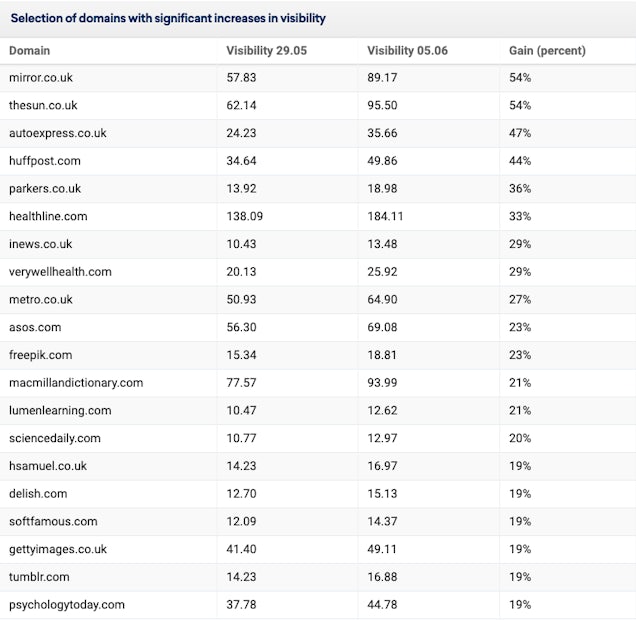
Source: Sistrix
Google’s advice regarding the update is to simply… do nothing.
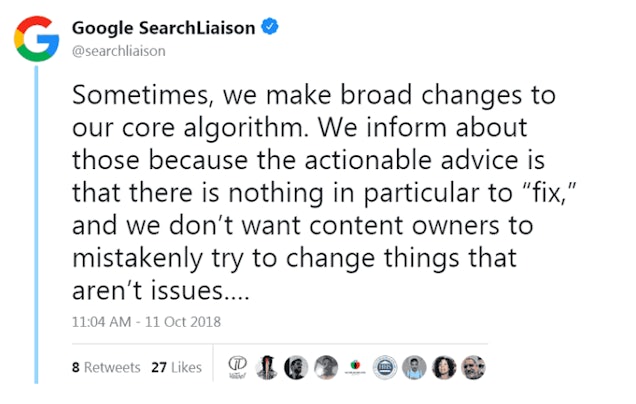
This advice should be taken with a pinch of salt, however. On the one hand, it does make sense to avoid wasting SEO resource on making changes to resolve any issues that may not even exist in the first place.
On the other hand, broad core algorithm updates usually take between seven to ten days to take effect, which means that SEOs would do well to wait before forming conclusions about their response. Moreover, these updates clearly take ‘site quality’ into account to judge relevancy, but this is not their sole focus.
If your website has lost rankings, it is best not to try to identify what is broken or not high enough quality, but rather consider whether your site is viewed as relevant anymore in the eyes of Google, and what is relevant about the sites that are performing better. If the algorithm update has negatively impacted your website, addressing a gap in relevancy might better serve your website than simply doing nothing.
May 9th Update

Around the start of May, we saw some discussions within the SEO industry of fluctuations within the SERPs. Some industry experts stated that this could’ve been the aftermath of the new evergreen GoogleBot being announced at the 2019 Google I/O event having the capability to crawl more pages and index pages more effectively.

May 22nd Update

During this time of the month, the tracking tools of SEOs across the globe were lighting up – suggesting that there was a search algorithm update in store.
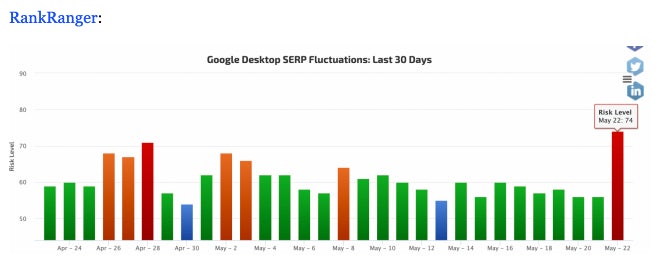
Around the same time, an indexing bug had affected the ability to search for content from the New York Times, Wall Street Journal or any other site and many believed that this was what had caused fluctuations in rankings.
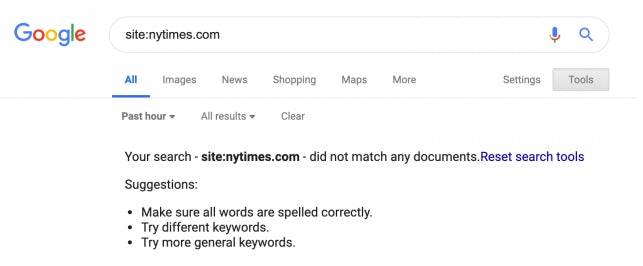
However, as the indexing bug only impacted new or updated URLs that Google was trying to index, it appears that the two could not be linked. Tracking tools such as Accuranker, SEMRush and Mozcast would not be impacted by new URLs until they had been properly indexed.
John Mueller was quick to brush off the May 22nd algorithm update, stating that Google makes tons of updates every year – leading us to believe that this might have just been a test for the June update that they rolled out soon after.
May 31st Update

Towards the end of last month, Google alleged that they had got considerably better at deciding the quality of medical and health types of websites.
Last August, Barry Schwartz identified that the August 2018 core update that was rolled out, was focused mainly on medical and nutrition and health-related websites. During this period, Google denied these claims, but analysis has shown that there was a target towards these sites and they were greatly affected during the rollout of this update.
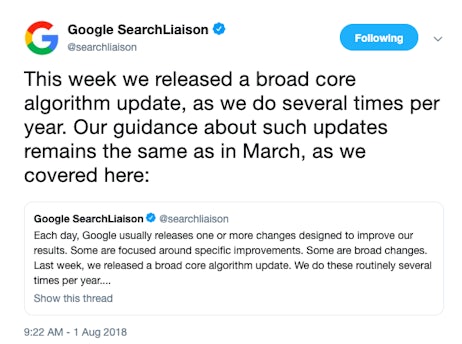
During a Google Webmasters Hangout on the 31st of May, John Mueller, Google’s Webmasters Trends Analyst, claimed that a year ago their algorithms got more intelligent around medical and health-related websites.
Within this discussion, he stated, “maybe our algorithms in the last year or so have been focusing more on and where they’re a bit more critical.” and “For example, one area that I’ve seen mentioned a lot is the whole medical space”
Despite this “global update”, chatter amongst the industry continues to believe the main focus was directed towards medical and health niches. Our advice here at Impression would be indefinitely to review E-A-T guidelines. Within the medical sector, it is important to be an expert within your field that is providing truthful advice, that you have authoritativeness within the industry and the making the user feel safe when browsing the site.
Favicon Search Results

During the 22nd of May, it was announced that Google are rolling out a new design to the SERPs. This mobile-first design includes the website name and favicon to surface at the top of the result page – ultimately affecting how paid advertisements are displayed.
As shown in the screenshot below, the paid listings have now been given a branded favicon and more of a subtle black ‘Ad’ icon, as opposed to the green one introduced over two years ago. This arguably can make it more difficult to distinguish from organic and paid advertisements.

Google states that this design change will help users to decide where they retrieve their information from and a website’s branding “can be front and centre, helping you better understand where the information is coming from and what pages have what you’re looking for.” Comments within the industry have been so far positive, making users more informed and helping them to identify websites of best use.
Cool things Google have done this month
When Google aren’t busy refining the search experience for users, they are also up to some other interesting things. Here are some of the things they did in May.
Algorithm to detect lung cancer
In the middle of May, Google AI and healthcare researchers had published research presenting a deep learning algorithm that they had successfully trained to detect lung cancer with a 94.4% success rate.
The findings indicated that the algorithm actually outclassed radiologists under certain circumstances. Meaning that Google (with the help of healthcare researchers) had effectively trained an algorithm to detect lung cancer better than radiologists.
According to the study, the algorithm achieved that success rate on 6,716 cases from the National Lung Cancer Screening Trial with the same accuracy on 1,139 clinical cases. Though there is still a long way to go in algorithmic identification in healthcare, it is still promising regardless.
Animal AR
At their I/O developer’s conference in May, Google announced that they were bringing out augmented reality models to allow users to look at a 3D image of their search result. The feature currently has a range of animals that you can check out in AR, including a tiger, a lion, a giant panda, a rottweiler, a wolf and more.

Shout out to Greg Holland for this one
The feature is available on AR-compatible mobile devices. Simply, search for the animal in Google and you will receive an invitation to meet it life-sized and up close. Then click “View in 3D” and the AR tab at the top of the screen. It might take a while and moving your phone around, but it’s worth it.
Google noted at I/O that the feature would be used for shopping, so users could see what a product looked like without having it in person. Google is also testing an AR navigation feature for Google Maps that we can hopefully report on very soon.



